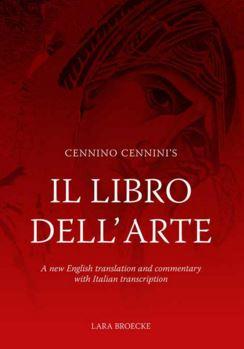Book review: Cennino Cennini’s Il Libro dell’arte A new English translation and commentary with Italian transcription by Lara Broecke
Submitted by bborghese on

A welcome addition to the conservator’s bookshelf is this new translation of Il Libro dell’Arte, the seminal writings about late medieval/early Renaissance painting techniques as observed by Cennino d’Andrea Cennini (c. 1370 – c. 1440). The unfinished Italian treatise is a study of art materials and their uses, spread over 245 chapters that cover an encyclopedic range of topics from choosing the right kind of chicken bones to burn and grind into a white ground layer, to how to cast a death mask.
The previously definitive version was Daniel V. Thompson’s 1933 translation, which was originally released by Yale University Press and subsequently had a long and happy life in many paperback editions, beginning in 1954, thanks to Dover Publications. With the easy-to-understand English language moniker The Craftman’s Handbook, Thompson’s translation has for many decades been central to the bibliography of technical studies of the Trecento, at least for anyone not willing to dive into the original Italian version, which was written probably in the 1390s.
The value of Thompson’s contribution to the literature notwithstanding, Broecke’s volume is nothing short of a revelation, especially for speakers of both English and Italian. If the Thompson version of the Cennini text was a quaint and useful volume for the artist, the conservator, and the art historian, Broecke’s text is a serious work of scholarship. A conservator trained at Oxford, Cambridge, and the Hamilton Kerr Institute, Broecke has tackled a monumental challenge and triumphed.
No original manuscripts in Cennini’s hand have survived, and Broecke has worked from two 15th-century versions in Florentine libraries, comparing throughout her book the one to the other. The bulk of the text is devoted to translating the treatise word by word from the Italian, in which the author goes so far as to correct typos in Cennini’s text, where he—or his transcriber several decades later--erroneously wrote a word in haste, from simple words (e.g. “coe” should read as “cioé,” or in English “that is”) to more complex concepts. For instance, in her footnote on her decision about how best to describe the perfect tool for incising a halo around the head of a saint on a fresco, she notes, “In the phrase una stecchetta de legnio forte…the adjective forte (strong) could describe either stecchetta (small palette knife) or legnio (wood)…I [apply] the adjective to the palette knife rather than to the wood.” The main text is followed by a 35-page section of notes that are devoted to putting her translation into the context of the Thompson text. Here Broecke enumerates the places and the ways in which her translation varies from the previously accepted version of Cennini’s original text, word by word and point by point.
Very little is known about the life of Cennino Cennini, but Broecke has put together the existing bits and pieces of archival evidence into a plausible chronology. Perhaps the most interesting revelation to come to light from her research is the well-considered theory in her introduction that Cennini’s work was not intended as a “how-to” manual for artists at all. She hypothesizes rather that it was a work of self-promotion (a “vanity project”) while Cennini was in residence at the royal court of Carrara in Padua. The evidence that she uses to support this claim is his faulty and incomplete information about pigments, as well as a number of recipes that were not kitchen tested. (The author preparing shell gold turned into a muddy mess.) Her theory about the motivation for the treatise is that, in an age when the “artist” was not in the same class as scholars but was still relegated to the ranks of “craftsman,” the Tuscan Cennini was showing off his expertise for the intellectual gentlemen at the Paduan court in order to gain acceptance, but that his knowledge about many of the topics that he addresses is far from complete.
If this new edition of Cennini’s observations on art-making is less readable than Thompson’s handbook, the herculean effort of Broecke’s interpretation of the 14th-century text more than compensates.
Will Shank, a Fellow of the IIC, was trained in art history and conservation at the Villa Schifanoia in Florence, at New York University’s Institute of Fine Arts, and at the Harvard University Art Museums. He was head of conservation at SFMOMA (The San Francisco Museum of Modern Art) throughout the 1990s and won the Rome Prize in Conservation/Heritage Preservation in 2005. Since 2006 he has been co-chair of the U.S. initiative Rescue Public Murals, for which he was granted the Advocacy Award by the American Institute of Conservation in 2010. He works privately in collections care, specialising in modern and contemporary paintings, from his base in Barcelona.